Citroen C4 PICASSO 2015 2.G Owner's Manual
Manufacturer: CITROEN, Model Year: 2015, Model line: C4 PICASSO, Model: Citroen C4 PICASSO 2015 2.GPages: 420, PDF Size: 10.72 MB
Page 211 of 420

209
Direction indicators
F Left: lower the lighting stalk passing the p
oint of resistance.
F
R
ight: raise the lighting stalk passing the
p
oint of resistance.
Three flashes of the direction
indicators
F Press briefly upwards or downwards, w
ithout going beyond the point of
r
esistance; the direction indicators will
f
lash 3 times.
Hazard warning lam ps
Visual warning by means of the direction i
ndicators to alert other road users to a vehicle
b
reakdown, towing or accident.
F
Press this button, the direction indicators flash.They can operate with the ignition off.
Automatic operation of
hazard warning lamps
When braking in an emergency, depending on the deceleration, the hazard warning lamps
c
ome on automatically.
They
switch off automatically the first time you
a
ccelerate.
F
Y
ou can also switch them off by pressing
t
he button.
Horn
F Press the central part of the steering w
heel.
6
Safety
Page 212 of 420
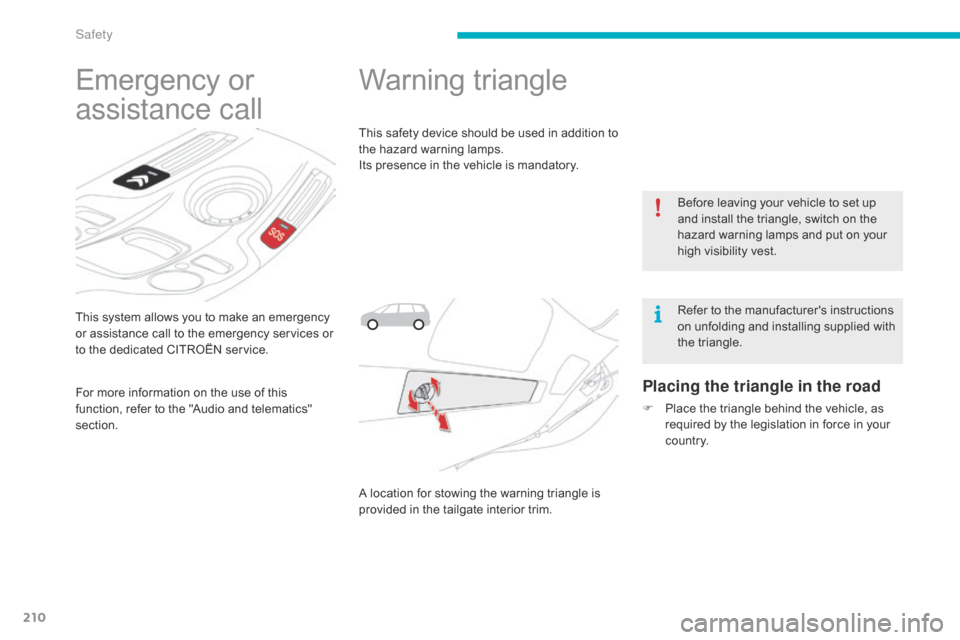
210
This system allows you to make an emergency or assistance call to the emergency services or
t
o the dedicated CITROËN service.
Emergency or
a
ssistance call
For more information on the use of this f
unction, refer to the "Audio and telematics"
s
ection.
Warning triangle
This safety device should be used in addition to the hazard warning lamps.
Its
presence in the vehicle is mandatory.
A
location for stowing the warning triangle is
p
rovided in the tailgate interior trim.
Placing the triangle in the road
F Place the triangle behind the vehicle, as r
equired by the legislation in force in your
c
o unt r y.Before
leaving your vehicle to set up
a
nd install the triangle, switch on the
h
azard warning lamps and put on your
h
igh visibility vest.
Refer to the manufacturer's instructions
o
n unfolding and installing supplied with
t
he triangle.
Safety
Page 213 of 420
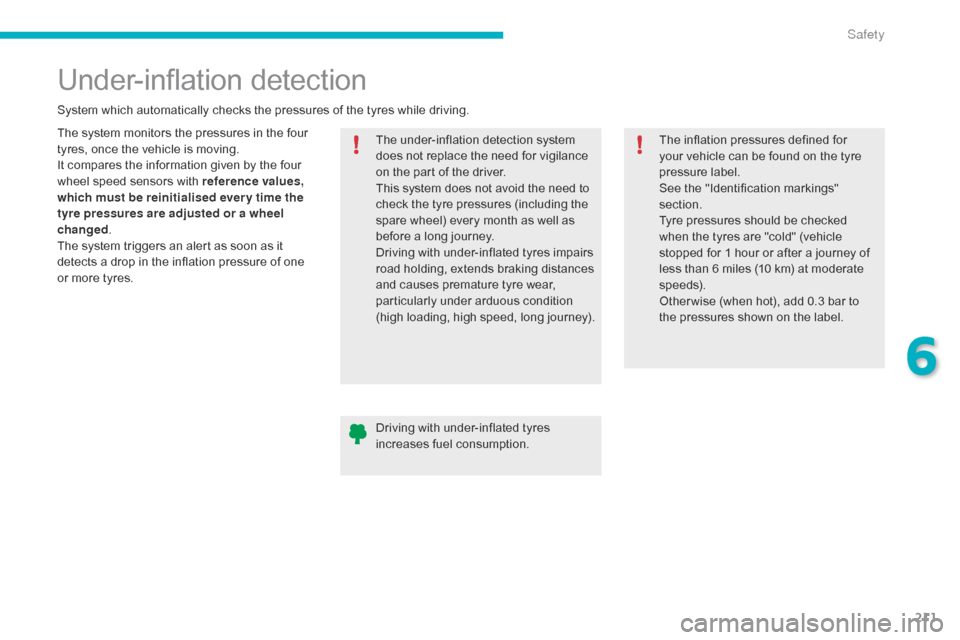
211
Under-inflation detection
The system monitors the pressures in the four t
yres, once the vehicle is moving.
It
compares the information given by the four
w
heel speed sensors with reference values,
which must be reinitialised ever y time the
tyre pressures are adjusted or a wheel
changed .
The
system triggers an alert as soon as it
d
etects a drop in the inflation pressure of one
o
r more tyres. The
under-inflation detection system
d
oes not replace the need for vigilance
o
n the part of the driver.
This
system does not avoid the need to
c
heck the tyre pressures (including the
s
pare wheel) every month as well as
b
efore a long journey.
Driving
with under-inflated tyres impairs
r
oad holding, extends braking distances
a
nd causes premature tyre wear,
p
articularly under arduous condition
(
high loading, high speed, long journey).
System
which automatically checks the pressures of the tyres while driving.
The inflation pressures defined for
y
our vehicle can be found on the tyre
p
ressure label.
See
the "Identification markings"
s
ection.
Tyre
pressures should be checked
w
hen the tyres are "cold" (vehicle
s
topped for 1 hour or after a journey of
l
ess than 6 miles (10 km) at moderate
s
peeds).
Other wise
(when hot), add 0.3 bar to
t
he pressures shown on the label.
Driving
with under-inflated tyres
i
ncreases fuel consumption.
6
Safety
Page 214 of 420
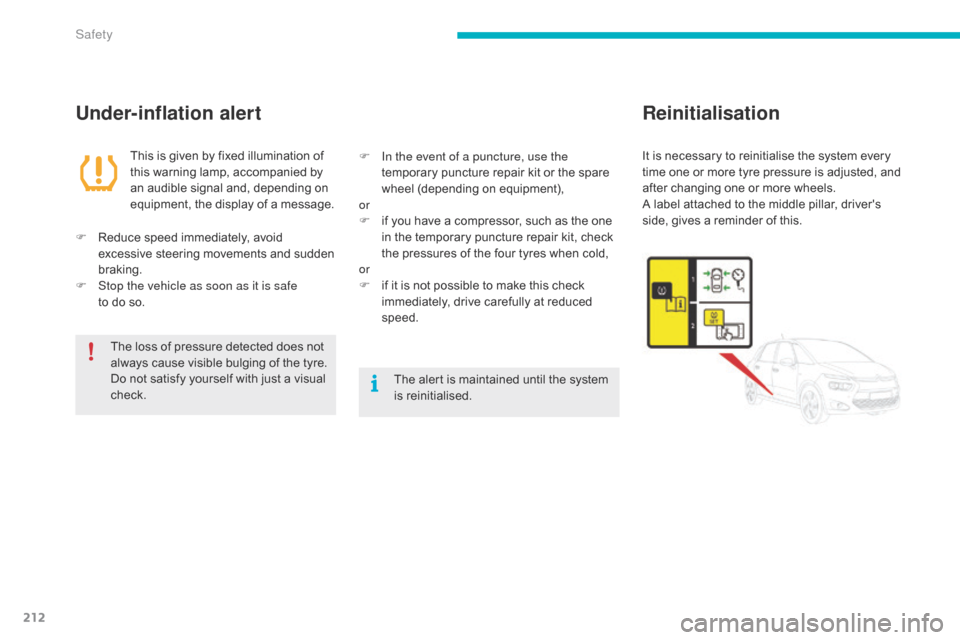
212
Under-inflation alertReinitialisation
This is given by fixed illumination of t
his warning lamp, accompanied by
a
n audible signal and, depending on
e
quipment, the display of a message. It
is necessary to reinitialise the system every t
ime one or more tyre pressure is adjusted, and
a
fter changing one or more wheels.
A
label attached to the middle pillar, driver's
s
ide, gives a reminder of this.
F
R
educe speed immediately, avoid
e
xcessive steering movements and sudden
b
raking.
F
S
top the vehicle as soon as it is safe
to
do
so. F
I n the event of a puncture, use the
temporary
puncture repair kit or the spare
w
heel (depending on equipment),
or
F
i
f you have a compressor, such as the one
i
n the temporary puncture repair kit, check
t
he pressures of the four tyres when cold,
or
F
i
f it is not possible to make this check
i
mmediately, drive carefully at reduced
s
peed.
The
loss of pressure detected does not
a
lways cause visible bulging of the tyre.
D
o
not satisfy yourself with just a visual
c
heck. The
alert is maintained until the system
i
s
r
einitialised.
Safety
Page 215 of 420
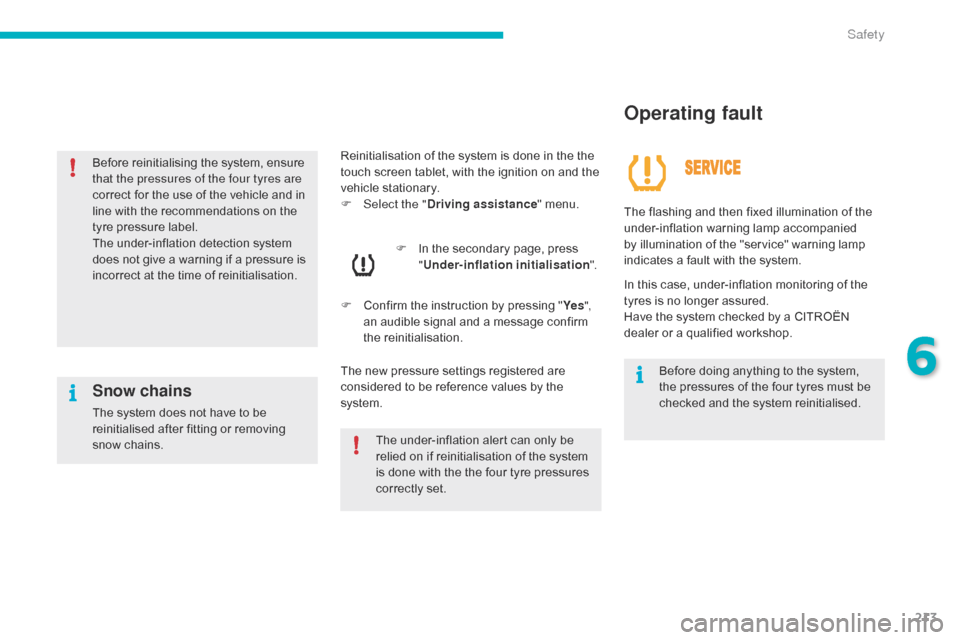
213
Reinitialisation of the system is done in the the touch screen tablet, with the ignition on and the
v
ehicle stationary.
F
Sel
ect the " Driving assistance "
menu.
F
I
n the secondary page, press
"U
nder-inflation initialisation ".
F
C
onfirm the instruction by pressing "Ye s ",
an
audible signal and a message confirm
th
e
r
einitialisation.
The
new pressure settings registered are
c
onsidered to be reference values by the
s
ystem.
Operating fault
The flashing and then fixed illumination of the u nder-inflation w arning lam p a ccompanied b
y illumination of the "service" warning lamp
i
ndicates a fault with the system.
In
this case, under-inflation monitoring of the
t
yres is no longer assured.
Have
the system checked by a CITROËN
d
ealer or a qualified workshop.
Before
doing anything to the system,
t
he pressures of the four tyres must be
c
hecked and the system reinitialised.
The
under-inflation
alert
can
only
be
r
elied
on
if
reinitialisation
of
the
system
i
s
done
with
the
the
four
tyre
pressures
c
orrectly
set.
Snow chains
The system does not have to be r einitialised after fitting or removing
sn
ow
c
hains.
Before
reinitialising the system, ensure
t
hat the pressures of the four tyres are
correct for the use of the vehicle and in
l
ine with the recommendations on the
t
yre pressure label.
The under-inflation detection system
d
oes not give a warning if a pressure is
i
ncorrect at the time of reinitialisation.
6
Safety
Page 216 of 420

214
Electronic Stability Control (ESC) incorporating the following systems:
-
a
nti-lock braking system (ABS) and the
e
lectronic brake force distribution (EBFD),
-
e
mergency braking assistance (EBA),
-
w
heel anti-slip regulation (ASR) or traction
c
ontrol,
-
d
ynamic stability control (DSC).
Electronic stability control (ESC)
Definitions
Anti-lock braking system (ABS)
and electronic brake force
distribution (EBFD)
This system improves the stability and manoeuvrability of your vehicle when braking
a
nd contributes towards improved control in
c
orners, in particular on poor or slippery road
su
rfaces.
The
ABS prevents wheel lock in the event of
em
ergency
b
raking.
The
electronic brake force distribution system
m
anages the braking pressure wheel by wheel.
Emergency braking assistance
(EBA)
In an emergency, this system enables you to reach the optimum braking pressure more
q
uickly and therefore reduce the stopping
di
stance.
It
is triggered according to the speed at which
t
he brake pedal is pressed. This is felt by a
r
eduction in the resistance of the pedal and an
i
ncrease in the effectiveness of the braking.
Anti-slip regulation (ASR)
The ASR system (also known as Traction Control) optimises traction in order to limit
w
heel slip by acting on the brakes of the driving
w
heels and on the engine. It also improves
t
he directional stability of the vehicle on
a
cceleration.
Dynamic stability control (DSC)
If there is a difference between the path followed by the vehicle and that required by
t
he driver, the DSC monitors each wheel and
a
utomatically acts on the brake of one or more
w
heels and on the engine to return the vehicle
t
o the required path, within the limits of the laws
o
f physics.
Safety
Page 217 of 420
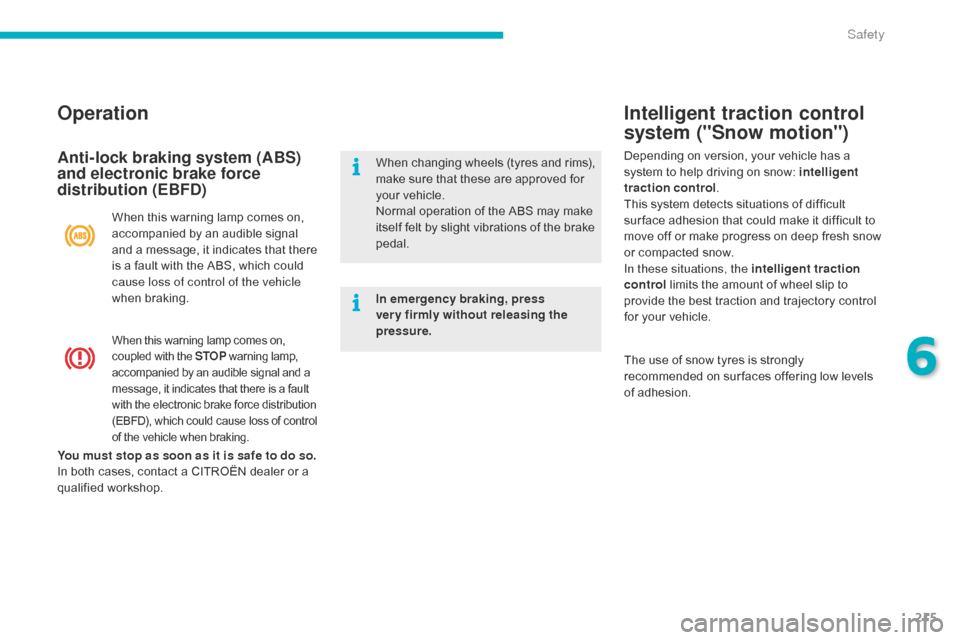
215
Intelligent traction control
system ("Snow motion")
When this warning lamp comes on, coupled with the STOP w arning lam p, a
ccompanied by an audible signal and a
m
essage, it indicates that there is a fault
w
ith the electronic brake force distribution
(
EBFD), which could cause loss of control
o
f the vehicle when braking.
Operation
When this warning lamp comes on, accompanied by an audible signal
a
nd a message, it indicates that there
i
s a fault with the ABS, which could
c
ause loss of control of the vehicle
when
b
raking. Depending
on version, your vehicle has a
s
ystem to help driving on snow: intelligent
traction control .
This system detects situations of difficult s
ur face adhesion that could make it difficult to
m
ove off or make progress on deep fresh snow
o
r compacted snow.
In these situations, the intelligent traction
control
limits the amount of wheel slip to
p
rovide the best traction and trajectory control
f
or your vehicle.
The
use of snow tyres is strongly
r
ecommended on sur faces offering low levels
o
f adhesion.
Anti-lock braking system (ABS)
and electronic brake force
distribution (EBFD)When changing w heels ( tyres a nd r ims), m
ake sure that these are approved for
y
our vehicle.
Normal
operation of the ABS may make
i
tself felt by slight vibrations of the brake
ped
al.
In emergency braking, press
very firmly without releasing the
pressure.
You must stop as soon as it is safe to do so.
In
both
cases,
contact
a
CITROËN
dealer
or
a
q
ualified
w
orkshop.
6
Safety
Page 218 of 420
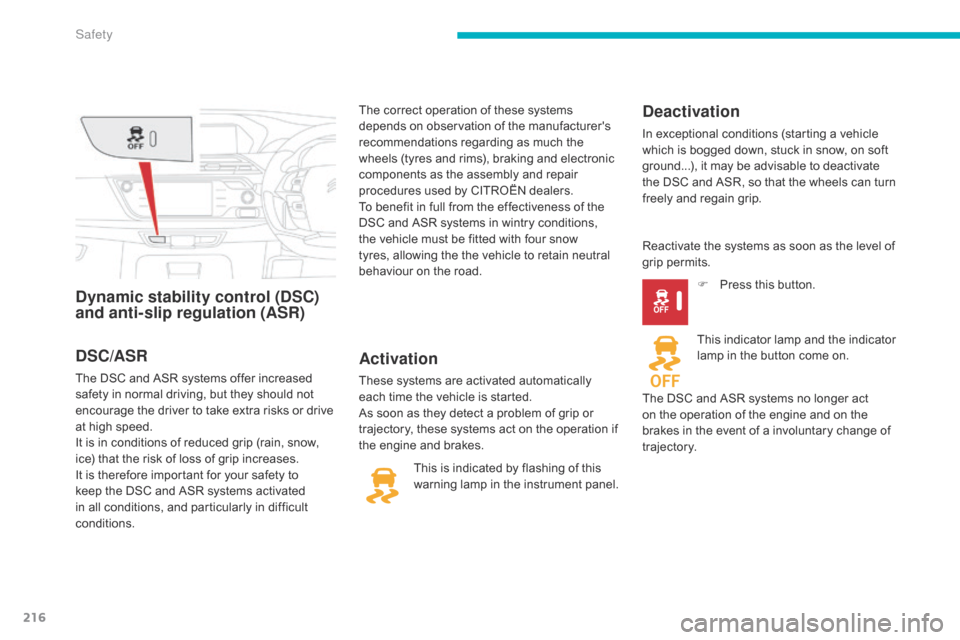
216
Dynamic stability control (DSC)
and anti-slip regulation (ASR)Activation
These systems are activated automatically each time the vehicle is started.
As
soon as they detect a problem of grip or
t
rajectory, these systems act on the operation if
t
he engine and brakes.
Deactivation
In exceptional conditions (starting a vehicle which is bogged down, stuck in snow, on soft
g
round...), it may be advisable to deactivate
t
he DSC and ASR, so that the wheels can turn
f
reely and regain grip.
This
is
indicated
by
flashing
of
this
w
arning
lamp
in
the
instrument
panel. Reactivate
the systems as soon as the level of
g
rip permits. F
P
ress this button.
This
indicator lamp and the indicator
l
amp in the button come on.
The
DSC and ASR systems no longer act
o
n the operation of the engine and on the
b
rakes in the event of a involuntary change of
t
rajectory.
DSC/ASR
The DSC and ASR systems offer increased s afety in normal driving, but they should not
e
ncourage the driver to take extra risks or drive
a
t high speed.
It
is in conditions of reduced grip (rain, snow,
i
ce) that the risk of loss of grip increases.
I
t is therefore important for your safety to
k
eep the DSC and ASR systems activated
i
n all conditions, and particularly in difficult
c
onditions. The
correct operation of these systems
d
epends on observation of the manufacturer's
r
ecommendations regarding as much the
w
heels (tyres and rims), braking and electronic
c
omponents as the assembly and repair
p
rocedures used by CITROËN dealers.
To benefit in full from the effectiveness of the
D
SC and ASR systems in wintry conditions,
t
he vehicle must be fitted with four snow
t
yres, allowing the the vehicle to retain neutral
b
ehaviour on the road.
Safety
Page 219 of 420
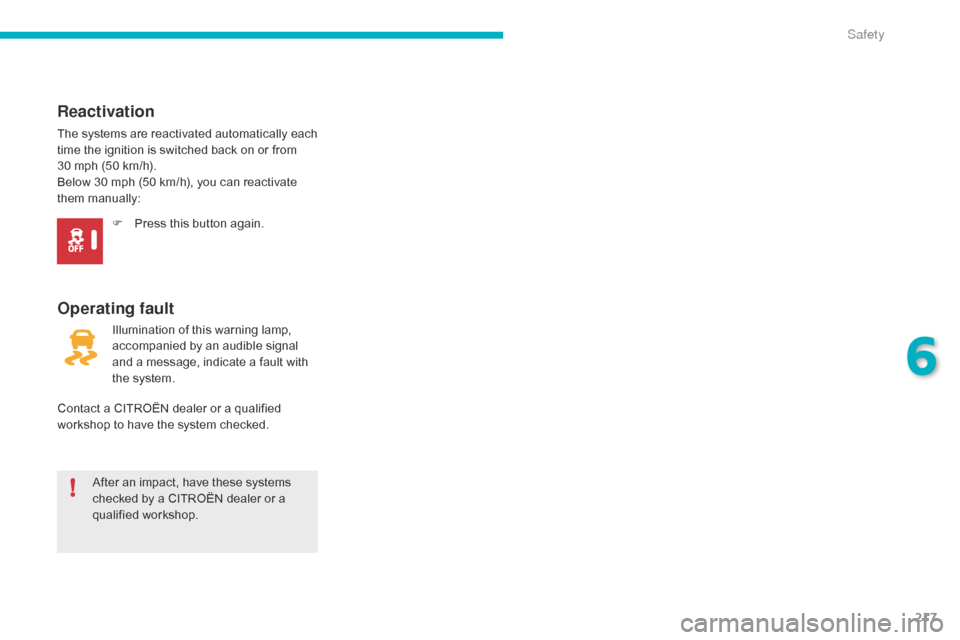
217
After an impact, have these systems checked by a CITROËN dealer or a
q
ualified
w
orkshop.
Operating fault
Reactivation
The systems
a re r eactivated a utomatically e ach t
ime the ignition is switched back on or from
3
0 mph (50 km/h).
Below
30 mph (50 km/h), you can reactivate
t
hem
m
anually:F
P
ress this button again.
Illumination
of this warning lamp,
a
ccompanied by an audible signal
a
nd a message, indicate a fault with
t
he system.
Contact
a CITROËN dealer or a qualified
w
orkshop to have the system checked.
6
Safety
Page 220 of 420
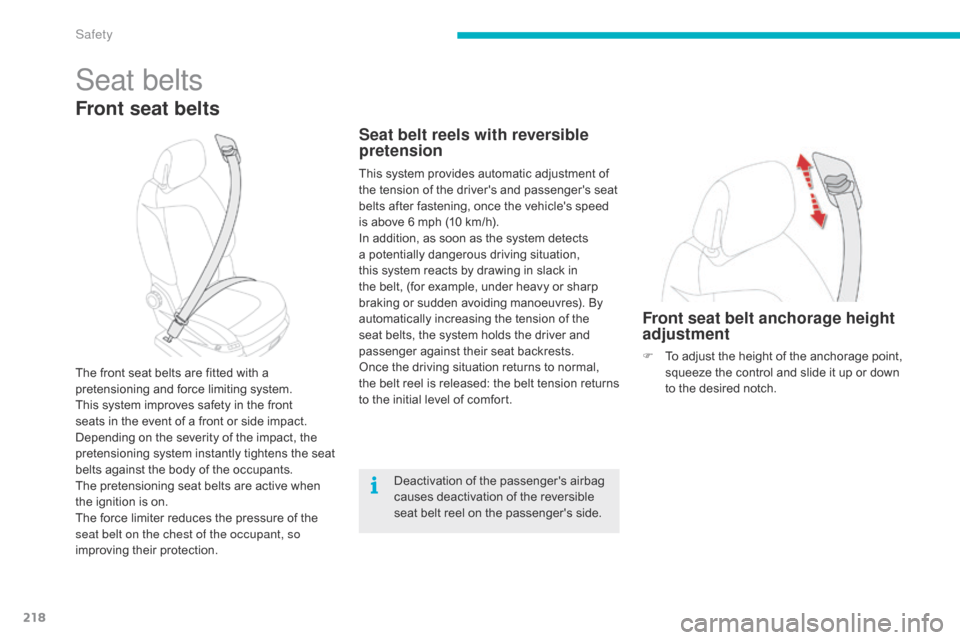
218
Seat belts
Front seat belts
The front seat belts are fitted with a pretensioning and force limiting system.
This
system improves safety in the front
s
eats in the event of a front or side impact.
D
epending on the severity of the impact, the
p
retensioning system instantly tightens the seat
b
elts against the body of the occupants.
The
pretensioning seat belts are active when
t
he ignition is on.
The
force limiter reduces the pressure of the
s
eat belt on the chest of the occupant, so
improving
their protection.
Seat belt reels with reversible
pretension
This system provides automatic adjustment of the tension of the driver's and passenger's seat
b
elts after fastening, once the vehicle's speed
i
s above 6 mph (10 km/h).
In
addition, as soon as the system detects
a
potentially dangerous driving situation,
t
his system reacts by drawing in slack in
t
he belt, (for example, under heavy or sharp
b
raking or sudden avoiding manoeuvres). By
a
utomatically increasing the tension of the
s
eat belts, the system holds the driver and
p
assenger
a
gainst
t
heir
sea
t
b
ackrests.
Once
the driving situation returns to normal,
t
he belt reel is released: the belt tension returns
t
o the initial level of comfort.
Deactivation
of the passenger's airbag
c
auses deactivation of the reversible
s
eat belt reel on the passenger's side.
Front seat belt anchorage height
adjustment
F To adjust the height of the anchorage point, s
queeze the control and slide it up or down
t
o the desired notch.
Safety